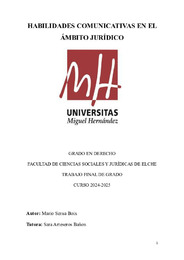Please use this identifier to cite or link to this item:
https://hdl.handle.net/11000/36500Habilidades comunicativas en el ámbito jurídico
| Title: Habilidades comunicativas en el ámbito jurídico |
| Authors: Serna Boix, Mario |
| Tutor: Arteseros Bañon, Sara |
| Editor: Universidad Miguel Hernández de Elche |
| Department: Departamentos de la UMH::Ciencia Jurídica |
| Issue Date: 2024 |
| URI: https://hdl.handle.net/11000/36500 |
| Abstract: El presente trabajo consiste en un estudio sobre la importancia de las habilidades comunicativas en ámbito jurídico y cómo son capaces de influir en la persuasión. La comunicación consiste en un proceso de interacción e intercambio de información entre las distintas partes que participan en ella. La comunicación puede tener diferentes objetivos: informar, dar a conocer, persuadir, convencer a alguien, modificar la conducta del receptor o simplemente expresarse. Se define la comunicación, dentro de la rama de Psicología de la Comunicación, como una función o capacidad psicológica, incluso existente antes de desarrollar su instrumento, el lenguaje. Las habilidades comunicativas, por lo tanto, son fundamentales para la puesta en práctica del Derecho, en un marco predominantemente oral. Estas incluyen la capacidad de transmitir información de manera persuasiva y clara, de escuchar activamente o la capacidad de adaptarse a diferentes audiencias, ya sean clientes y testigos hasta jueces y jurados. Es de especial trascendencia el funcionamiento de la persuasión jurídica, siendo esta la capacidad de construir argumentos sólidos, exponerlos de manera clara y convincente para influir de manera notoria en las decisiones judiciales. Se desarrollan también las posibles dificultades o resistencias a las que se puede enfrentar quien participe en un proceso comunicativo, siendo algunas las discrepancias con el propio cliente, la actitud del juez durante la intervención, las protestas del abogado contrario o el interrogatorio de un testigo hostil o favorable que modifica su declaración. A demás, deberemos exponer la posibilidad de entrenamiento de habilidades emocionales, habilidades de comunicación para transmitir el mensaje (interrogatorio o exposición), seguridad y capacidad de respuesta, capacidad estratégica, comunicación no verbal… Finalmente, se realizará un análisis sobre la incidencia de la comunicación oral y no verbal en casos reales. The present work consists of a study on the importance of communication skills in the legal field and how they are able to influence persuasion. Communication is a process of interaction and exchange of information between the different parties involved. Communication can have different objectives: to inform, to make known, to persuade, to convince someone, to modify the behavior of the receiver or simply to express oneself. Communication is defined, within the branch of Psychology of Communication, as a psychological function or capacity, even existing before the development of its instrument, language. Communication skills, therefore, are fundamental for the implementation of law, in a predominantly oral framework. These include the ability to convey information persuasively and clearly, to listen actively, or the ability to adapt to different audiences, from clients and witnesses to judges and juries. It also delves into the workings of legal persuasion, which is the ability to construct solid arguments and present them in a clear and convincing manner in order to influence judicial decisions in a noticeable way. We also develop the possible difficulties or resistances that may be faced by those who participate in a communicative process, such as disagreements with the client, the judge's attitude during the intervention, the protests of the opposing lawyer or the interrogation of a hostile or favorable witness who modifies his statement. In addition, the possibility of training emotional skills, communication skills to convey your message (cross-examination or exposure), confidence and responsiveness, strategic skills, non-verbal communication, etc. will also be discussed. Finally, an analysis will be made on the incidence of oral and non-verbal communication in real cases. |
| Keywords/Subjects: Habilidades comunicativas en derecho Persuasión Argumentación jurídica Oratoria en procesos judiciales Communication skills in law Persuasion Legal argumentation Oratory in judicial proceedings |
| Knowledge area: CDU: Ciencias sociales: Derecho |
| Type of document: info:eu-repo/semantics/bachelorThesis |
| Access rights: info:eu-repo/semantics/openAccess |
| Appears in Collections: TFG- Derecho |
.png)

